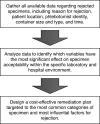Targeting Rejection: Analysis of Specimen Acceptability and Rejection, and Framework for Identifying Interventions in a Single Tertiary Healthcare Facility
- PMID: 27629723
- PMCID: PMC6816912
- DOI: 10.1002/jcla.22060
Targeting Rejection: Analysis of Specimen Acceptability and Rejection, and Framework for Identifying Interventions in a Single Tertiary Healthcare Facility
Abstract
Objectives: Assessment of specimen rejection rates is an important laboratory quality measure for laboratories because of a potential negative impact on patient care. Here, we examined reasons for specimen rejection at a single, tertiary care healthcare institution and propose a framework for designing an efficient intervention.
Methods: During a 1-year period, we identified all specimens rejected at our hospital and performed an analysis of a wide range of associated variables: reason for rejection, patient location, type of phlebotomist, tests ordered, priority status, collection container used, transport time.
Results: Clotted and hemolyzed specimens accounted for the majority of rejected specimens, but significant differences in reasons for specimen rejection existed between patient care areas. Eighty-five percent of rejected specimens came from the Emergency Department and eight other inpatient care areas. Registered nurses drew approximately 85% of rejected specimens, while laboratory phlebotomy staff drew only 4%.
Conclusions: While hemolysis and clotting are primary causes for specimen rejection, collection of all available data regarding specimen rejection data is essential for laboratories determining which factors are most significant causes of specimen rejection.
Keywords: laboratory management; laboratory quality assurance; specimen rejection rate.
© 2016 Wiley Periodicals, Inc.
Figures


References
-
- Karcher DS, Lehman CM. Clinical consequences of specimen rejection a College of American Pathologists Q‐probes analysis of 78 clinical laboratories. Arch Pathol Lab Med 2014;138:1003–1008. - PubMed
-
- Jacobsz LA, Zemlin AE, Roos MJ, Erasmus RT. Chemistry and haematology sample rejection and clinical impact in a tertiary laboratory in Cape Town. Clin Chem Lab Med 2011;49:2047–2050. - PubMed
-
- Green SF. The cost of poor blood specimen quality and errors in preanalytical processes. Clin Biochem 2013;46:1175–1179. - PubMed
-
- Alsina MJ, Alvarez V, Barba N, et al. Preanalytical quality control program – An overview of results (2001–2005 summary). Clin Chem Lab Med 2008;46:849–854. - PubMed
-
- Bonini P, Plebani M, Ceriotti F, Rubboli F. Errors in laboratory medicine. Clin Chem 2002;48:691–698. - PubMed
MeSH terms
LinkOut - more resources
Full Text Sources
Other Literature Sources

